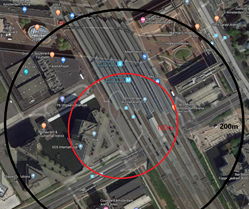Cable Pooling: Electric Buses
Witteveen+Bos is an international multidisciplinary and independent engineering and environmental company of Dutch origin, with approximately 1,300 professionals spread over 20 offices in 11 countries. Witteveen+Bos is strongly connected to universities, within this framework internships, and master thesis in the field of electrical engineering are part of our strategy. This paper is providing more insights on a thesis developed on the topic of Cable Pooling.
“The biggest challenge at the moment is to estimate how much power is needed ”, says Van Rookhuijzen. He spoke on behalf of ELAADNL during a conference on zero-emission mobility of the Amsterdam Transport Region. During this day, the mobility sector and the energy sector were brought together because in 2030 the emissions of public bus transport must be zero. This will save 320 kilotons of CO2 per year, compared to 2018. The route to this zero-emission bus transport is shown in the overview in the left column.
Over the past four years, Witteveen+Bos has done all kinds of projects in this area, for example: feasibility studies in Zwolle, Breda and the Gooi- en Vechtstreek, designing the charging infrastructure for buses in Zwolle and the depot for buses in Utrecht. Also the automation of bridges and high voltage projects for, among others, TENNET.
As a result of this zero-emission goal, PricewaterhouseCoopers (PwC) has conducted research into improving the realisation of zero-emission bus transport. PwC emphasises that effective cooperation with the various parties will ensure the lowest social costs.
This has raised the question of how Witteveen+Bos can contribute with a Cable Pooling strategy and what the potential can be. In a nutshell, what is the effect of Cable Pooling on the use of the grid connection in a charging infrastructure for buses?
Definition of Cable Pooling
The definition of Cable Pooling is the optimisation of the use of the grid connection by bundling different consumers. A distinction is made between the three variants of figure 1: sharing everything (charging method and infrastructure), sharing charging infrastructure and sharing grid connection.

Figure 1: Possibilities of Cable Pooling.
Limited space
One of the advantages of bundling charging infrastructure is the space that will be saved. If we consider where the major bus stations are located, the space available for charging infrastructure is limited. Ideally, the radius of the circle where both the pantograph and the charging infrastructure should be located between 100 and 200 meters.
For example, the Amsterdam Bijlmer ArenA bus station, shown in figure 2, is located in the middle of a densely built-up area. Next to the bus station with multiple carriers, there is a train and subway station, a stadium and several parking garages and offices. Since Cable Pooling reduces the use of space, it could the right solution for a location like the Amsterdam Bijlmer ArenA.

Figure 2: Limited space at Amsterdam Bijlmer ArenA.
Cable Pooling applied
If Cable Pooling is applied, the potential situation will be compared with the situation as it will be if Cable Pooling is not applied. These two situations are called Cable Pooling and No Cable Pooling.
No Cable Pooling is the standard situation in which each carrier installs and manages its own charging infrastructure and grid connection. For example, in a hypothetical situation four carriers of a location have installed their own infrastructure. The profiles of the power usage of each carrier in the busiest hour of the week are shown in figure 3. If we take a look at the power usage of each carrier, it is notable is it never constant.
Cable Pooling is the potential situation where the cable pooling strategy is applied. In this hypothetical location, the usage of the different carriers is added together and it results in the line Cable Pooling. One of the advantages of Cable Pooling is a more efficient use of the installation so that the average usage of the grid connection is much lower. So, when Cable Pooling is applied optimal use is made of the installation. In addition to this, Cable Pooling is a space saving and cost saving, both capital and operational, strategy. However, there are no savings on energy consumption, only on the grid connection costs.

Figure 3: Energy usage example bus station with four carriers.
Energy usage is still far from constant and it has been partially optimised by adding a charging plaza for electric cars. This is the ‘Cable Pooling & Charging Plaza’-line of figure 3. The power available to use at the charging plaza depends on the efficiency of the use of the grid connection, in this study a maximum 30% of the total usage. Although this evens out most highs and lows, further research is necessary to achieve the optimal situation. For example, research can be done into peak shaving or other solutions to optimise the usage of the grid connection. Are you interested in doing research at Witteveen+Bos? Let us know!
Witteveen+Bos projects
We believe in the strength of a personal touch and the added value of working together. In addition to the specially tailored internships, graduations and jobs we design together with each individual, we organise two multidisciplinary weeks in which we tackle a problem with a small team, work towards a solution and develop this into a Proof of Concept. Or, when we have higher expectations, a team works within a week to a defined solution. This way we stay up to date with the latest technologies, knowledge and developments.
Are you interested in an internship, to graduate or to work at Witteveen+Bos? Contact us at theo.ludlage@witteveenbos.com or take a look at the vacancies at our website.
